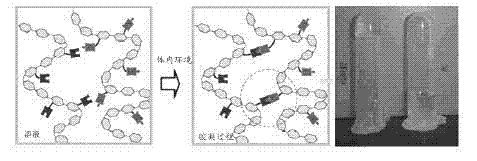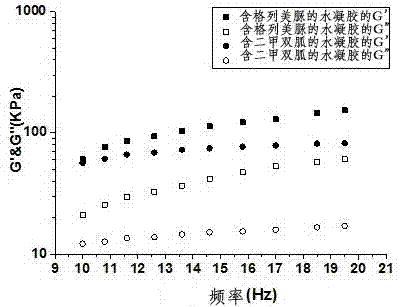Preparation method of injectable self-curing hypoglycemic hydrogel
A hydrogel and hypoglycemic technology, applied in the field of biomedical engineering, to achieve stable degradation speed, reduce costs, and enhance compliance
- Summary
- Abstract
- Description
- Claims
- Application Information
AI Technical Summary
Problems solved by technology
Method used
Image
Examples
Embodiment 1
[0024]Add 5.0 g of dextran, 2.0 g of lithium chloride, and 100 mL of anhydrous DMF into the reaction vessel, raise the temperature to 90°C, stir until completely dissolved, stop heating and drop to room temperature, then add 0.9 g of pyridine, and place in an ice bath Add 2.2 g of PNC in batches, react at room temperature for 24 h (the reaction process is carried out under the protection of nitrogen), under the condition of ice bath, drop the reaction solution into 200 mL of ethanol, filter the solid, wash with ethanol several times, and use Wash with ether and dry under vacuum at room temperature to obtain a dextran intermediate (DP6) with a substitution degree of 6%. Weigh 2 g of DP6 and add 80 μL of furfurylamine to 40 mL of anhydrous DMF, and react at room temperature for 48 h . Under the condition of ice bath, the reaction solution was dropped into 50 mL of ethanol, the solid was collected by suction filtration, washed with ethanol several times and then washed with ether...
Embodiment 2
[0026] Add 5.0 g of dextran, 2.0 g of lithium chloride, and 100 mL of anhydrous DMF to the reaction vessel, raise the temperature to 90°C, stir until completely dissolved, stop heating and cool down to room temperature, then add 1.8 g of pyridine, and place in an ice bath Add 4.4 g of PNC in batches, react at room temperature for 24 h (the reaction process is carried out under nitrogen protection), under ice bath conditions, the reaction solution is dripped into 200 mL of ethanol, and the solid is collected by suction filtration, washed with ethanol for several times Wash with ether and dry under vacuum at room temperature to obtain a dextran intermediate (DP15) with a substitution degree of 15%. Weigh 2 g of DP15, add 20 mL of anhydrous DMF, and add 180 μL of furfurylamine after complete dissolution, and react at room temperature for 48 h . Under the condition of ice bath, the reaction solution was dropped into 50 mL of ethanol, the solid was collected by suction filtration, ...
Embodiment 3
[0028] Add 5.0 g of dextran, 2.0 g of lithium chloride, and 100 mL of anhydrous DMF into the reaction vessel, raise the temperature to 90°C, stir until completely dissolved, stop heating and cool down to room temperature, then add 3.6 g of pyridine, and place in an ice bath Add 8.8 g of PNC in batches, react at room temperature for 24 h (the reaction process is all carried out under the protection of nitrogen), under the condition of ice bath, drop the reaction solution into 200 mL of ethanol, filter the solid, wash with ethanol several times and use Wash with ether and dry under vacuum at room temperature to obtain a dextran intermediate (DP60) with a substitution degree of 60%. Weigh 2 g of DP60, add 20 mL of anhydrous DMF, and add 230 μL of furfurylamine after complete dissolution, and react at room temperature for 48 h . Under the condition of ice bath, the reaction solution was dropped into 50 mL of ethanol, the solid was collected by suction filtration, washed with ethan...
PUM
| Property | Measurement | Unit |
|---|---|---|
| degree of substitution | aaaaa | aaaaa |
Abstract
Description
Claims
Application Information
 Login to View More
Login to View More - R&D
- Intellectual Property
- Life Sciences
- Materials
- Tech Scout
- Unparalleled Data Quality
- Higher Quality Content
- 60% Fewer Hallucinations
Browse by: Latest US Patents, China's latest patents, Technical Efficacy Thesaurus, Application Domain, Technology Topic, Popular Technical Reports.
© 2025 PatSnap. All rights reserved.Legal|Privacy policy|Modern Slavery Act Transparency Statement|Sitemap|About US| Contact US: help@patsnap.com



